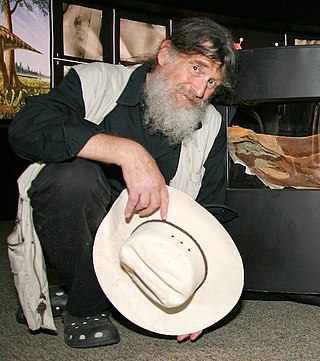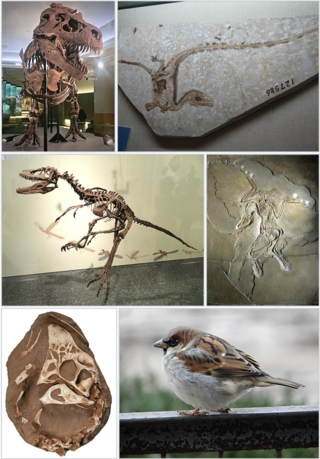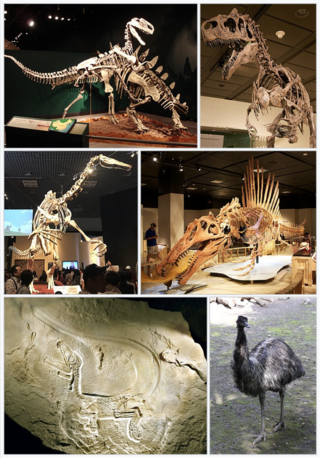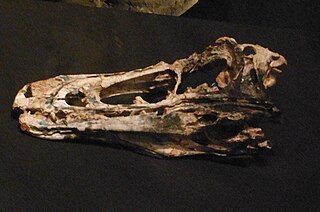
Dinosaurs are a diverse group of reptiles of the clade Dinosauria. They first appeared during the Triassic period, between 243 and 233.23 million years ago (mya), although the exact origin and timing of the evolution of dinosaurs is a subject of active research. They became the dominant terrestrial vertebrates after the Triassic–Jurassic extinction event 201.3 mya and their dominance continued throughout the Jurassic and Cretaceous periods. The fossil record shows that birds are feathered dinosaurs, having evolved from earlier theropods during the Late Jurassic epoch, and are the only dinosaur lineage known to have survived the Cretaceous–Paleogene extinction event approximately 66 mya. Dinosaurs can therefore be divided into avian dinosaurs—birds—and the extinct non-avian dinosaurs, which are all dinosaurs other than birds.

Theropoda (; from ancient Greek θηρίο-ποδός [θηρίον, "wild beast"; πούς, ποδός "foot"] whose members are known as theropods, is a dinosaur clade that is characterized by hollow bones and three toes and claws on each limb. Theropods are generally classed as a group of saurischian dinosaurs. They were ancestrally carnivorous, although a number of theropod groups evolved to become herbivores and omnivores. Theropods first appeared during the Carnian age of the late Triassic period 231.4 million years ago and included the majority of large terrestrial carnivores from the Early Jurassic until at least the close of the Cretaceous, about 66 Ma. In the Jurassic, birds evolved from small specialized coelurosaurian theropods, and are today represented by about 11,000 living species.

John Robert Horner is an American paleontologist most famous for describing Maiasaura, providing the first clear evidence that some dinosaurs cared for their young. In addition to his paleontological discoveries, Horner served as the technical advisor for the first five Jurassic Park films, had a cameo appearance in Jurassic World, and served as a partial inspiration for one of the lead characters of the franchise, Dr. Alan Grant. Horner studied at the University of Montana, although he did not complete his degree due to undiagnosed dyslexia, and was awarded a Doctorate in Science honoris causa. He retired from Montana State University on July 1, 2016, although he claims to have been pushed out of the Museum of the Rockies after having married an undergraduate student and now teaches as a Presidential Fellow at Chapman University.

Robert Thomas Bakker is an American paleontologist who helped reshape modern theories about dinosaurs, particularly by adding support to the theory that some dinosaurs were endothermic (warm-blooded). Along with his mentor John Ostrom, Bakker was responsible for initiating the ongoing "dinosaur renaissance" in paleontological studies, beginning with Bakker's article "Dinosaur Renaissance" in the April 1975 issue of Scientific American. His specialty is the ecological context and behavior of dinosaurs.

Maniraptora is a clade of coelurosaurian dinosaurs which includes the birds and the non-avian dinosaurs that were more closely related to them than to Ornithomimus velox. It contains the major subgroups Avialae, Dromaeosauridae, Troodontidae, Oviraptorosauria, and Therizinosauria. Ornitholestes and the Alvarezsauroidea are also often included. Together with the next closest sister group, the Ornithomimosauria, Maniraptora comprises the more inclusive clade Maniraptoriformes. Maniraptorans first appear in the fossil record during the Jurassic Period, and survive today as living birds.

Coelurosauria is the clade containing all theropod dinosaurs more closely related to birds than to carnosaurs.

Tetanurae is a clade that includes most theropod dinosaurs, including megalosauroids, allosauroids, tyrannosauroids, ornithomimosaurs, compsognathids and maniraptorans. Tetanurans are defined as all theropods more closely related to modern birds than to Ceratosaurus and contain the majority of predatory dinosaur diversity. Tetanurae likely diverged from its sister group, Ceratosauria, during the late Triassic. Tetanurae first appeared in the fossil record by the Early Jurassic about 190 mya and by the Middle Jurassic had become globally distributed.

John Harold Ostrom was an American paleontologist who revolutionized the modern understanding of dinosaurs. Ostrom's work inspired what his pupil Robert T. Bakker has termed a "dinosaur renaissance".

The New Dinosaurs: An Alternative Evolution is a 1988 speculative evolution book written by Scottish geologist and palaeontologist Dougal Dixon and illustrated by several illustrators including Amanda Barlow, Peter Barrett, John Butler, Jeane Colville, Anthony Duke, Andy Farmer, Lee Gibbons, Steve Holden, Philip Hood, Martin Knowelden, Sean Milne, Denys Ovenden and Joyce Tuhill. The book also features a foreword by Desmond Morris. The New Dinosaurs explores a hypothetical alternate Earth, complete with animals and ecosystems, where the Cretaceous-Paleogene extinction event never occurred, leaving non-avian dinosaurs and other Mesozoic animals an additional 65 million years to evolve and adapt over the course of the Cenozoic to the present day.
Peter Douglas Ward is an American paleontologist and professor at the University of Washington, Seattle, and Sprigg Institute of Geobiology at the University of Adelaide. He has written numerous popular science works for a general audience and is also an adviser to the Microbes Mind Forum. In 2000, along with his co-author Donald E. Brownlee, he co-originated the term Rare Earth and developed the Medea hypothesis alleging that multicellular life is ultimately self-destructive.

Scansoriopteryx is a genus of maniraptoran dinosaur. Described from only a single juvenile fossil specimen found in Liaoning, China, Scansoriopteryx is a sparrow-sized animal that shows adaptations in the foot indicating an arboreal (tree-dwelling) lifestyle. It possessed an unusual, elongated third finger which may have supported a membranous wing, much like the related Yi qi. The type specimen of Scansoriopteryx also contains the fossilized impression of feathers.
Eshanosaurus is a genus of a dinosaur from the early Jurassic Period. It is known only from a fossil partial lower jawbone, found in China. It may be a therizinosaurian, and if so the earliest known coelurosaur.
Xu Xing is a Chinese paleontologist who has named more dinosaurs than any other living paleontologist. Such dinosaurs include the Jurassic ceratopsian Yinlong, the Jurassic tyrannosauroid Guanlong, the large oviraptorosaur Gigantoraptor, and the troodontid Mei.

The Day of the Dinosaur is a science book by L. Sprague de Camp and Catherine Crook de Camp, illustrated with plates. It was first published in hardcover by Doubleday in 1968, and in paperback by Curtis Books in 1970 or 1971. A second hardcover edition was issued by Bonanza Books in 1985. The first chapter was reprinted as "One Day in the Cretaceous" in the de Camps's collection Footprints on Sand.

John Alan Feduccia is a paleornithologist specializing in the origins and phylogeny of birds. He is S. K. Heninger Distinguished Professor Emeritus at the University of North Carolina. Feduccia's authored works include three major books, The Age of Birds, The Origin and Evolution of Birds, and Riddle of the Feathered Dragons.

Hesperornithoides is a genus of troodontid theropod dinosaur that lived in North America during the Late Jurassic period.

Matthew Bonnan is an American paleobiologist, a Professor of Biological Sciences at Stockton University, and as of 2021 a singer/songwriter. His research combines traditional descriptive and anatomical study with computer-aided morphometric analysis and modeling of vertebrate skeletons, and he is the co-discoverer of three new species of dinosaurs. He is the author of the book The Bare Bones: An Unconventional Evolutionary History of the Skeleton, designed to introduce undergraduates and curious lay readers to the anatomy and evolution of the vertebrate skeleton. Bonnan has a music/art outreach project, Once Upon Deep Time, a pop/rock song cycle about the evolution of hearing and our connection to the tree of life.

Haplocheirus is an extinct genus of theropod dinosaur from the Middle Jurassic Shishugou Formation of Xinjiang in China. It is generally considered to be an alvarezsauroid, although some researchers have questioned this assignment. The genus contains a single species, H. sollers, which is known from a mostly complete skeleton including the skull.

Alvarezsauroidea is a group of small maniraptoran dinosaurs. Alvarezsauroidea, Alvarezsauridae, and Alvarezsauria are named for the historian Gregorio Álvarez, not the more familiar physicist Luis Alvarez, or his son geologist Walter Alvarez who jointly proposed that the Cretaceous–Paleogene extinction event was caused by an impact event. The group was first formally proposed by Choiniere and colleagues in 2010, to contain the family Alvarezsauridae and non-alvarezsaurid alvarezsauroids, such as Haplocheirus, which is the basalmost of the Alvarezsauroidea. The discovery of Haplocheirus extended the stratigraphic evidence for the group Alvarezsauroidea about 63 million years further in the past. The division of Alvarezsauroidea into the Alvarezsauridae and the non-alvarezsaurid alvarezsauroids is based on differences in their morphology, especially in their hand morphology.

Paleontology in the United States refers to paleontological research occurring within or conducted by people from the United States. Paleontologists have found that at the start of the Paleozoic era, what is now "North" America was actually in the southern hemisphere. Marine life flourished in the country's many seas. Later the seas were largely replaced by swamps, home to amphibians and early reptiles. When the continents had assembled into Pangaea drier conditions prevailed. The evolutionary precursors to mammals dominated the country until a mass extinction event ended their reign.
















